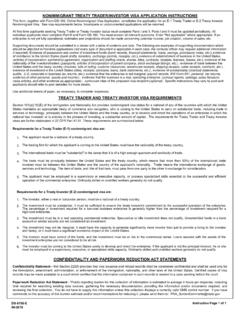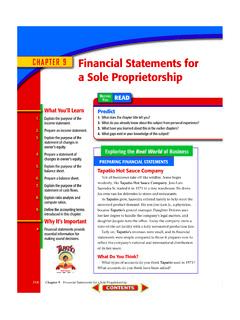Transcription of RISK MANAGEMENT GUIDE - UFX.COM
1 RISK MANAGEMENT GUIDE . 1. CONTENTS. Contents 2. Introduction 3. I. Basic Principles of CFD Trading 3. Contracts For Difference 3. Leverage and Margin 3. Spreads 4. Pip Calculation 4. Rollover Fees 5. Expiration Dates 6. II. Risks Involved in Trading. 6. Losses 6. Margin Call and Stop Out 7. Market Volatility 8. Slippage 9. III. Risk MANAGEMENT Tools 10. Equity Drop Alert 10. Stop Loss Orders 11. Take Profit 13. Manual Closure of Trades 14. Conclusion 15. 2. INTRODUCTION. This risk MANAGEMENT GUIDE 's purpose is to alert and explain the main risks trading online may pose to new traders over the course of their trading career. Even if you have experience in trading leveraged products, we strongly suggest that you carefully read this GUIDE . The goal of this GUIDE is to ensure traders are supplied with a sound foundation of trading information in order to understand the importance of building a robust Risk MANAGEMENT Plan as a fundamental prerequisite of a successful trading career.
2 This applies to all traders, both new and experienced. By having a solid understanding of the risks involved in trading and being aware of the trading tools available, traders can enhance their ability to minimise exposure to risks. Risk MANAGEMENT is essential to the success of any trader . Success may be defined as the point where trades return more profits than losses. As such, it is crucial that as a trader you realise that potential losses are as integral and important a part of trading as potential profits. A correct approach to risk MANAGEMENT attributes equal importance to both of these fundamental aspects. Developing a personal trading strategy is crucial to every trader 's success. It is of particular importance for you to develop a unique trading and risk MANAGEMENT strategy of your own, as any decisions and actions you take regarding trading are your sole and absolute responsibility. As a consequence, you will also be fully responsible for the results of your trading decisions and actions, whether they be profits or losses.
3 As such, you should not underestimate the importance of having a solid understanding of the principles, risks, and tools presented in this GUIDE . The following section will present the fundamental principles of CFD trading. Comprehensive knowledge of these principles is necessary to understand the risk factors you may be exposed to while trading. A more in-depth analysis of these specific risk factors will be presented in the second section of this GUIDE . Finally, the third section will focus on the tools available for managing the risks. I. The Basic Principles of CFD Trading A solid grasp of the fundamental principles of CFD trading is crucial for managing your risk. The next section of this GUIDE will present you with a variety of different forms of risk that should serve as the basis for every trader 's risk MANAGEMENT plan. Contracts For Difference A contract for difference (CFD) is a derivative financial instrument with an underlying asset, meaning you do not physically own the underlying asset.
4 A CFD is an agreement between the buyer and seller to exchange the difference in the current value of the underlying asset, such as a share, currency, commodity, or index and its value at the end of the contract. As derivatives, the price levels of CFDs are directly related to those of their underlying assets, and are thus affected by market volatility in the underlying instrument market. Please refer to the below section on Market Volatility for more information. Leverage and Margin CFDs are a leveraged product, which means that you only need to deposit a small percentage of the full value of the trade in order to open a position. You are able to leverage your investment by opening positions of a larger size than the funds you have in your account. This is called trading on margin (or margin requirement). 3. With leverage you are investing a fraction of the trade's value, but your position will return profits and losses as if you had invested the full value of the CFD position.
5 It is crucial that you understand that leverage will inflate both your profits and losses. For an example of how leverage affects profits and losses, please see the section below on Losses. Leverage is expressed as a ratio of X:1 where X is the leverage. Most currencies have a leverage of 400:1, so we can say that the leverage is 400. Stocks usually have a lower leverage of 20:1 so the leverage is 20. The margin requirement is directly related to leverage. It is the expression in percentage of the leverage ratio. A leverage of 20 means a margin requirement of 5% (20:1 = 1/20 = (1/20 100) % =. 100/20 % = 5 %). For example: You decide to buy 4000 CFDs of Share A at the price of $10 per CFD. Your position is therefore $40,000. (4000 x $10). You will not actually pay $40,000: the amount you will pay depends on the margin required by the CFD. If the CFD trades with a leverage of 20 (margin requirement of 5%) the required margin would be calculated as follows: a) (Amount x price)/leverage 4000 x $10/20 = 2000$.
6 OR. b) (Amount x price) x margin requirement %. 40000 x $10 x 5% = $2000. This means that your minimum initial payment is $2000 instead of $40,000. You require an initial balance (margin) of $2000 in your account to open this trade. Spreads The Bid/Ask Spread is the difference between the Bid and the Ask prices available for each asset. Whenever you open a trade, you will start with a loss. That loss amount is the spread, and will appear automatically on every trade you open. If you open trades worth a large percentage of your equity, the initial loss due to the spread may bring your account balance dangerously close to Stop Out levels. To avoid such situations, you should be aware of the spread amount you will have to pay before opening the trade and refrain from trading in volumes which are too risky for your account's balance. You can calculate the value of the spread by calculating the value of the pips, as shown in the section below.
7 Each asset has a different spread which is published on our website. You can also find the spread of each asset on our platform and are strongly encouraged to study the lists. Before opening a position, you should bear the spread of the asset in mind. You can also read more on how the Spread works in our Best Execution Policy. 4. Pip Calculation Calculating the pip value of your trades is a fundamental principle of managing your risk exposure and can give you better control over your trades. Once you have calculated the value of the pip, you will be able to know the impact (in terms of profit or loss) of any price fluctuations in the market. The formula for pip calculation is as follows: For currency Pip Value = (Pip in decimal places * Trade Size) 10. Example: Trading 100,000 of the pair EUR/USD. One pip in decimals = Trade Size = 100,000. * 100,000 = 10. Each pip is worth $10. If the account currency is not the same as the second currency in the pair ( , for any pair that is not XXX/USD), you will need to divide the value of the pip by the exchange rate, so the value will be in dollars.
8 In this case the calculation is as follows: (Pip in decimal places * Trade Size)/Market Price Example: Buying 100,000 of the pair AUD/CAD. One pip in decimals = Trade Size = 100,000. * 100,000 = 10. Pip value = 10. USD/CAD price: 10 = Each pip is worth $ Rollover Fees UFX does not charge a rolling commission. What we do charge is a rollover fee (also known as an overnight swap). The rollover fee is calculated when a trader leaves a position open past 00:00 GMT. The term rollover refers to the interest rate that traders will pay, or receive, on the open positions that are rolled over from one day to the next. Every currency pair has its own interest rate. At the end of every trading day, at 00:00 GMT, the trader will pay or receive the interest rate on the currency pairs they hold. In the trading market, interest is calculated on a daily basis. At the end of each trading day, at 00:00. GMT, traders can see from their account statement if they were charged or received the rollover fee.
9 On regular weekdays, the rollover rate is charged for the previous trading day. As the trading week has five days, on Wednesdays, rollover interest for the next weekend is charged for three days. The following is a brief explanation of rollover interest: The interest rate of the main currency is lower than that of the secondary currency. For Example: EUR/AUD. EUR - Interest rate of ; AUD - interest rate of The Euro is the main currency of the pair and its interest rate is lower than that of the secondary currency, which is the Australian Dollar (AUD). Buy/Long: When the trader buys the Euro, he will be charged the rollover fee. Sell/Short: When the trader sells the Euro, he will receive the rollover fee. NOTE: Trade volumes affect the amount of the rollover fee; the larger the volume traded, the larger 5. the rollover fee. Rollover fees are charged as follows: From Sunday night to Monday: regular rollover fee From Monday night to Tuesday: regular rollover fee From Tuesday night to Wednesday: regular rollover fee From Wednesday night to Thursday: rollover fee is charged three times (for Wednesday, Friday, and Saturday).
10 From Thursday night to Friday: regular rollover fee In very specific situations, namely when your balance is very low, if you allow Rollover fees to add up, this might drop your balance below the Stop Out level and thus trigger a Stop Out. Expiration Dates Some underlying assets have contracts with a limited lifetime and a specific expiration date. As such, it is strongly recommended that you refer to our website's up-to-date list with the expiration dates of underlying assets. When the expiration date is reached all open deals based on that asset will be closed automatically at the market rate of the expiration date. This means that, depending on the market rate, your trades may close with a profit or a loss. As such, it is very important that you make yourself aware of the expiry dates before opening a trade so you are not surprised by an unexpected closure and the unexpected consequences such an event may generate. Being aware of the time frame within which you will be able to trade a certain asset before you initiate the trade is a basic but extremely important factor in managing your risks.





